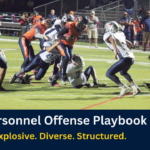Defending the Jet Sweep Play

The Jet Sweep is a difficult play for any defense to defend. The heart of what makes the Jet Sweep so difficult to defend is the play design. The play is designed to get the the ball in one of the offense’s most dynamic players hands on the edge quickly. Because of the speed of the motion, it’s critical that the defense has a clear understanding of who the Force player is so that they can come up and make the tackle.
Defending the Jet Sweep Play
To truly understand how to stop the Jet Sweep it’s important to understand a few key roles in defensive football. These key roles are Force Defender and Near Deep Defender. In any defense each side of the formation needs a Force Defender and a Near Deep Defender.
The Force Defender has the responsibility to make any tackle that is coming outside of the box. Depending on the defensive philosophy the Force defender will take on blocks one of two ways. The first way is to take on blocks while maintaining outside leverage to force the runner back inside. The other option is by coming inside of the blocks and force the ball carrier to bounce the ball to the sideline.
Related Content: How to Contain a Mobile Quarterback
The Near Deep Defender is the player who is responsible for covering any deep passes on that side of the field. This is normally a Safety or a Cornerback. The key element is that this defender must get back in case there are any play action passes or half back passes. The Near Deep Defender should never be making a tackle behind the Line of Scrimmage because he shouldn’t come forward until the ball crosses the line of scrimmage.
Now that we have clarified the responsibilities of the Force Defender and the Near Deep Defender we can talk about how they are used to stop the Jet Sweep. The best way to stop the Jet Sweep is to have the Force Defender close to the Line of Scrimmage. Where teams get in trouble is when their Force Defender can’t make it to the Line of Scrimmage before the Ball Carrier gets there. If the Force Defender is coming from a Safety position (like in a Cover 4 or the Strong Side of a Cover 3) then they must move closer to the Line of Scrimmage as the motion occurs. If the Force defender is coming from a Cornerback position they can move closer to the edge so they can make the tackle before the player is able to turn upfield. If the Force Defender is the overhang linebacker than he is already in a good position and does not need to adjust to the motion.
Related Content: Defending the Spread Offense in Youth Football
When a defense is able to get the Force Defender to the Line of Scrimmage quickly and make the tackle for a loss or a short gain you can guarantee that there is a Play Action pass coming soon. This makes the roll of the Near Deep Defender important. The only thing that allows the Force Defender to play so aggressively is that he has a Near Deep Defender covering any deep pass.
The critical part of teaching this concept is to make sure both the Near Deep Defender and the Force Defender know their role. Teams get in trouble when the offense is able to use a quick motion and get the Jet Sweep player attacking the edge quickly. If the defenders aren’t 100% sure on who the Force Defender and the Near Deep Defender are this can create an situation where the offense can make a big play.
Defense is about making sure players know their alignment and assignment so they are free to play fast and make tackles. When preparing for a team that runs the Jet Sweep it’s critical that the Defensive coaches make sure the players know who is the Force Defender and Near Deep Defender in every formation. Once the players know this they can react to the motion and shut down both the Jet Sweep but also any Play Action pass that comes with it.











